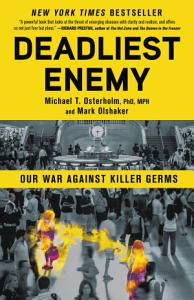
“We are learning how to die with this virus and we have to learn how to live with it.”
— Michael Osterholm, nationally renowned University of Minnesota epidemiologist and author of “Deadliest Enemy: Our War Against Deadly Germs”.
By Glenn Howat
Minneapolis Star Tribune (5/1/20)
The growing COVID-19 pandemic could last up to two years, with a potential second wave in the fall, according to nationally renowned University of Minnesota epidemiologist Michael Osterholm and a team of researchers.
The exact path the disease will take is unclear, but with no vaccine and a global population that had no immunity to the new coronavirus, COVID-19 could follow patterns seen in previous pandemics.
That means that governments will need to continually adjust their pandemic responses to waves of infections, which could have several peaks, rather than a distinct period of illnesses that burns out in a matter of months.
“We are learning how to die with this virus and we have to learn how to live with it,” said Osterholm, director of the Center for Infectious Disease Research and Policy at the U and a frequent infectious disease expert on national cable news programs.
Dr. Anthony Fauci, the nation’s top infectious disease physician, said this week that he thinks a fall wave of new cases was “inevitable.”
Reviewing eight global influenza pandemics over hundreds of years, the researchers noted that three pandemics since 1918 have been characterized by an initial wave of cases in the spring, followed by a larger wave in the fall.
The first wave tends to be concentrated in some areas, subsides during the summer and then becomes widespread in the fall. …
- ‘Joe Rogan Experience’ Interview With Michael Osterholm — Michael Osterholm is an internationally recognized expert in infectious disease epidemiology. He is Regents Professor, McKnight Presidential Endowed Chair in Public Health, the director of the Center for Infectious Disease Research and Policy (CIDRAP), Distinguished Teaching Professor in the Division of Environmental Health Sciences, School of Public Health, a professor in the Technological Leadership Institute, College of Science and Engineering, and an adjunct professor in the Medical School, all at the University of Minnesota. Look for his book “Deadliest Enemy: Our War Against Deadly Germs” for more info. https://amzn.to/2IAzeLe: Link To 1-Hour, 34-Minute Video
- Ralph Nader Radio Hour — Infectious disease expert, Dr. Michael Osterholm, comes back to update us on the latest in the battle against Covid-19. And Naila Bolus, president and CEO of “Jumpstart,” joins us to talk about how the money spent on early education gives society a tremendous return on investment. Link To 70-Minute Audio
*****
Political Scientist Lays Out ‘3 new developments’ That Prove The Coronavirus ‘nightmare’ Won’t End Anytime Soon
‘A bleak picture’
By Alex Henderson
AlterNet (4/28/20)
Journalist Yascha Mounk, in an article for The Atlantic as well as a Twitter thread, on Tuesday offered a sobering analysis of the ongoing coronavirus, emphasizing that Americans must prepare themselves for a “darker reality” and realize that “prospects for deliverance” from “this nightmare” are “remote.”
Mounk’s Twitter thread is essentially a condensed version of his Atlantic article, and he lays out his reasons why Americans shouldn’t expect a quick and easy solution to the crisis.
“Three new developments add up to a bleak picture: deliverance is not in sight,” Mounk tweets.
Mounk notes that in recent weeks, he had “three great hopes for how to end the nightmare: (1) fatality rates might be much lower than we thought. (2) An effective treatment could become available soon. (3) We could put an effective test-and-trace system in place.” But the journalist quickly adds that “all three hopes now seem remote” and goes on to explain why. …
